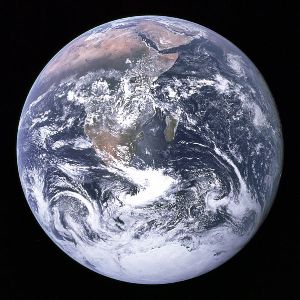by Larry
August, 2013The Out of This World Origins of Tap WaterThe usual answers take us only so far. Pipes brought the water from our metropolitan reservoir. It in turn was filled (not nearly enough lately as Austin has been in a long drought, but that is another story) by inflow from rivers and watersheds which in turn are replenished by rainfall and creeks. The rainfall occurs by a process more complicated than one might imagine, including the intervention, believe it or not, of airborne bacteria and of dusts, some from as far away as Asia and Africa. Yet fundamentally, it falls periodically from moisture-laden clouds that gain their accumulation of water through evaporation, primarily from Earth's vast swaddling seas that cover about two-thirds of our planet.
End of story? No, not at all, for in its early days the newly formed third planet circling around Sol, our Sun, had both a very thin atmosphere and great heat (to appreciate which think of an active volcano involving most of the surface of the world), so that liquid water (that of course boils at 100°C) could not have been present any length of time. Instead, our current watery world status must have only developed after much cooling had already occurred and a protective layer of air was also present, conditions that required first the passage of many millions of years from Earth's still fiery beginnings. Water is a common enough phenomenon in space, we learn, for its constituent atoms, hydrogen and oxygen, are fairly stable and exist in relatively large quantities within the material universe. When they mingle in the right temperature range, two atoms of hydrogen frequently merge with one of oxygen, and water molecules result. Still, how, after any initial surface water on Earth would have boiled away into space, did we acquire the enormous quantity we experience today as oceans, glaciers, ice caps, rivers, lakes, springs, other underground water sources, and even the majority of the molecules present in living things? Research and debate continue, but it appears the answer to this puzzle, as well as to dramatic transformations of our sphere's surface in other ways, lies with comets or asteroids. Both have pelted Earth repeatedly throughout the planet's existence. Often they contain water, usually in the form of ice, during their journeys toward high-speed collisions with our atmosphere or the planet's surface. They may be thought of as container ships from space, each bearing a load of valuable water. Tens of thousands of impacts must have occurred for every billion years of our planet's history. Each water-laden comet and asteroid thus added its special delivery for Earth. Certain chemical tags of our water seem to match a little better the watery signatures of ice from asteroids vs. from comets, according to sampling done so far, yet the final decision has not been made as to which is the predominant source of our seas. If it turns out that asteroids were the primary basis of modern Earth's oceans, it brings a whole new meaning to the term "meteor showers!" The wonder is, though, that most of the beauty and life-giving sustenance we appreciate in our oceans, from which in turn derive all other natural sources of this liquid on our orb, and even life on Earth itself, has almost certainly come from distant parts of the Solar System, a system that we are learning is also much more complex and marvelous than earlier believed.
Primary source: How Did Water Come to Earth? Brian Greene in Smithsonian Magazine; June, 2013, pages11-12. |
